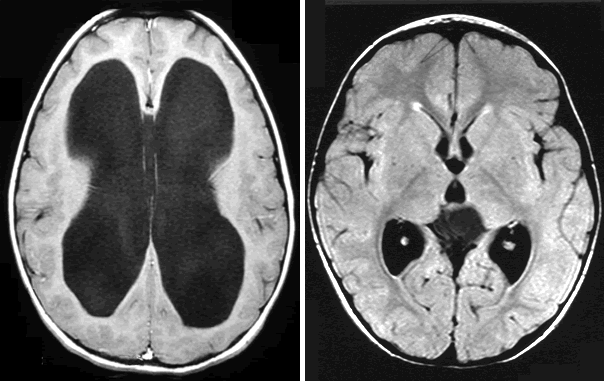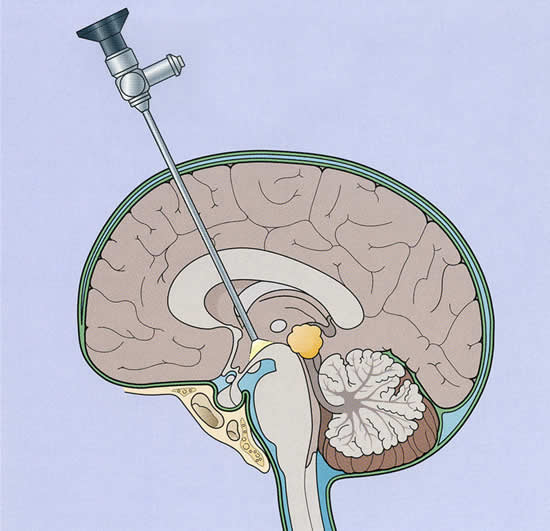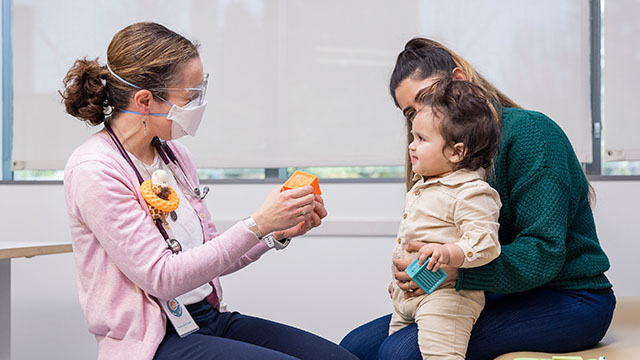Hydrocephalus
What is hydrocephalus?

An MRI scan of a brain with hydrocephalus (left) and a normal MRI scan (right). The large dark area on the left is the ventricles, made bigger by a build-up of CSF.
Hydrocephalus (hi-droh-SEF-eh-less) is a harmful buildup of in the spaces of your child’s brain, called . Hydrocephalus means water (hydro) in the head (cephalus). This problem is sometimes called water on the brain. The “water” is actually CSF. CSF is a clear fluid that bathes and protects your child’s brain and .
Your child’s body is always making and absorbing CSF. When CSF cannot flow or does not get absorbed as it should, fluid builds up. The buildup puts pressure on your child’s brain. Without treatment, hydrocephalus can cause problems with how your child’s brain develops and how it works. Pressure on the brain from hydrocephalus can be deadly.
Causes of hydrocephalus
CSF may not be able to flow as it should because of the way your child’s brain formed. This is called hydrocephalus.
Hydrocephalus that happens for any other reason is called acquired hydrocephalus. Causes include:
- Bleeding inside the ventricles of the brain
- Head injury
- Brain infection
- Brain tumor
Neurosciences Care at Seattle Children's
Symptoms of Hydrocephalus
Symptoms are different in babies and in older children.
-
Symptoms in babies
In babies, the most common symptoms are:
- Head growth that is larger than normal
- Bulging spots (fontanelles) on your baby’s head that may be soft or firm
- Wide spots between the flat bones of the skull (splayed sutures)
- Eyes that seem to look down all the time (sunsetting eyes). The white part of the eye can be seen above the colored part. The colored part is partly covered by the lower eyelid. This gives your baby a surprised look.
- Poor eating
- High-pitched cry
- Sleepiness
- Crankiness
-
Childhood symptoms
Children who develop hydrocephalus often have these symptoms:
- Headache
- Nausea and vomiting
- Low energy and sleepiness
- Problems with thinking or memory
- Vision changes
Diagnosing Hydrocephalus
Doctors will examine your child, looking for signs of hydrocephalus. Doctors also use to see signs of hydrocephalus. These tests include:
- Ultrasound
- CT (computed tomography) scan
- MRI (magnetic resonance imaging)
At Seattle Children’s we also use methods such as low-dose CT scans and rapid-sequence MRI that lower your child’s exposure to radiation.
Treating Hydrocephalus
All children with hydrocephalus need surgery to help CSF drain from their brain. Some children also have a procedure that reduces how much CSF their brain makes.
Treatment options include:
- Using a tube () to drain CSF to another part of the body, where it is absorbed
- Making a channel in the brain so CSF can flow a different way (endoscopic third ventriculostomy or ETV)
- Heating part of the ventricles in the brain so the tissue makes less CSF (choroid plexus cauterization or CPC)
Sometimes neurosurgeons treat hydrocephalus with an endoscope, a thin tube with a very small camera at the end. This tool lets surgeons see inside the body and perform surgeries. Endoscopic procedures involve smaller cuts (incisions) than open surgery.
-
Surgery to place a shunt
The most common treatment for hydrocephalus is surgery to put in a tube (shunt). The shunt drains extra CSF from ventricles in your child’s brain to another part of their body. The body then absorbs the fluid. Draining extra CSF from the brain creates normal pressure inside your child’s head.
We place shunts with GPS guidance, using during surgery. Our neurosurgeons use different shunts and valves, based on your child’s needs.
-
Endoscopic third ventriculostomy (ETV)

An endoscope being used to make a hole in the ventricle so the patient can avoid needing a shunt.
For a small number of children, an endoscopic third ventriculostomy (ETV) surgery may be an option instead of shunt surgery. Your neurosurgeon will talk with you about treatment options based on your child’s brain structures and age.
During an ETV, the neurosurgeon:
- Makes a small hole in your child’s skull
- Uses a rigid endoscope to go into the third ventricle and make a hole in the bottom of it
CSF flows out of this hole and reaches the normal places around the brain, where it is absorbed.
Children who have an ETV may avoid complications that can happen with shunts, such as infections or needing a shunt replaced (shunt revision). In carefully selected patients, ETV has a high success rate. But some children who have an ETV need to have a shunt put in later.
-
Choroid plexus cauterization (CPC)
If your child’s body is not absorbing CSF well, a choroid plexus cauterization (CPC) may be a treatment option. This procedure may avoid the need for a shunt in the future. We do it during the same surgery as ETV.
In CPC, the neurosurgeon:
- Uses a flexible endoscope to reach the in the lateral in each side of the brain
- Sends an electric current to this tissue
Why choose Seattle Children’s for your child’s hydrocephalus care?
Seattle Children’s neurosurgery team is expert at treating and managing this condition. All children with hydrocephalus will need some type of surgery to divert the CSF fluid and take pressure off their brain. Most patients need a tube (shunt) placed in their brain to drain extra fluid. We also offer an option that may avoid the need for a shunt — with . We perform more than 200 hydrocephalus surgeries a year. See our Neurosciences statistics and outcomes.
We partner with your family for ongoing care. Our team is on call 24/7 to triage all concerns about hydrocephalus via our clinic or Emergency Department (ED). We see your child at least yearly in clinic and work with your local provider, so your child gets the right care at the right time.
If your child needs urgent treatment, Seattle Children’s is the only hospital in the region with coverage by a neurosurgery team 24 hours a day, 7 days a week. Our Emergency Department offers round-the-clock access to Seattle Children’s specialists and the full facilities of our hospital.
For critically ill babies, we have the only neonatal neurocritical care program in Washington, Wyoming, Alaska, Montana and Idaho. If hydrocephalus causes problems in your child’s thinking, balance, learning or emotions, experts in our Neurodevelopmental Clinic will help them reach their full potential.
We are international leaders in hydrocephalus research. Seattle Children’s is part of a group of leading children’s hospitals that work together on research studies () to improve hydrocephalus care for all children. The group is called the Hydrocephalus Clinical Research Network (HCRN).
-
Advances to make surgery safer for your child
- We make 3D models of your child’s brain before surgery and operate with GPS (global positioning system) guidance to precisely place the shunts.
- To reduce the risk of infection, we use a standard process for shunt surgery and give antibiotics before and after surgery. Our infection rates are less than half of the national average.
- Our surgeons are experienced in shunt surgeries and the alternative, called ETV, for select patients. In endoscopic third ventriculostomy (ETV), neurosurgeons create a pathway in the brain to improve how CSF flows and is absorbed. Surgeons may also heat the part of the brain that makes CSF. This procedure is called choroid plexus cauterization (CPC). Your doctor will offer this option if it’s a good choice for your child.
- Because children who have hydrocephalus need many imaging scans of their heads during their lifetime, we use rapid-sequence MRI to avoid exposing them to radiation. If scans are needed, we use only ¼ to ½ of the usual dose of radiation.
-
Research to improve care
- Dr. Ghayda Mirzaa researches the basis for hydrocephalus. Our goal is to find new ways to prevent this condition or treat it without surgery.
- Seattle Children’s is a national leader in research to improve shunts and lower rates of shunt failure.
- As part of the Hydrocephalus Clinical Research Network (HCRN), we study the condition and develop new treatments. Current research compares outcomes for children who have surgery to place a shunt compared to ETV surgery.
-
Specialists in caring for kids and teens
- Children don’t react to illness, pain, medicine or surgery in the same way as adults. They need — and deserve — care designed just for them. Our team is specially trained to understand and meet their needs.
- Our doctors are focused on how today’s treatment will affect your child as they develop and become an adult.
- Our experts base their treatment plans on years of experience and the newest research on what works best — and most safely — for children and teens.
-
Support for your whole family
- Having a child with hydrocephalus can be stressful for the whole family. During visits, we take time to explain your child’s condition. We help you fully understand your treatment options, so you can choose what’s right for your family.
- Our doctors, , nurses, and help your child and your family through the challenges of their condition. We connect you to community resources and support groups.
- At Seattle Children’s, we work with children and families from around the Northwest and beyond. We can help with financial counseling, schooling, housing, transportation, interpreter services and spiritual care. Read about our services for patients and families.
Contact Us
If you would like an appointment, ask your child’s primary care provider for a referral. If you have a referral, call 206-987-2016 to make an appointment.
Providers, see how to refer a patient.
If you have questions, contact us at 206-987-2016 or 844-935-3467 (toll free).
Paying for Care
Learn about paying for care at Seattle Children’s, including insurance coverage, billing and financial assistance.

